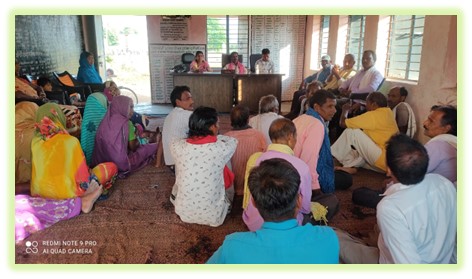



“Furfundi” means a flying insect, it is believed that previously people of these villages use to fly like bird/kite and they never use to walk to go to other places, hence the name of the village is given as a “furfundi” 200 hundred years back furfundi village, an informal settlement outside the bar-Nawa Para Forest boundaries of kasdol block was established. The settlement started as a small village inhabited mostly by less than 10/12 tribal houses. Over the years expanded to accommodate a population of 451 as on today. Despite its rapid growth, furfundi retained its informal status with little development of infrastructure and services.
If one looks back at the history, initially those who have come was staying in dense forest, full of natural resources, totally dependent on it, away from the main habitation etc. These dwellers stared to live in the houses which were constructed from bamboo tress, as time passed so as the things changed, people started to build mud houses and now at present many villagers are staying in the houses made of bricks. The total population is app451 as per 2011 census. The population is dominated by Bariha tribe followed by painkara, few houses of pardhi and one or two houses of other cast. Mainly cash crop is grown in this area. Paddy take the foremost place in terms of production, followed by NTFP and vegetables from kitchen Garden. The daily wages come from NREGA and forest department. The village have one anganwadi and lower primary schools up to the 5th class. In case of high school children has to travel borsi village which is 8/10km and 20 km to kasdol block to have college education. Gram panchayat of this village is located 8km away from this village, that means furfundi gram panchayat is located district at a distance of 20 km from the block headquarters and 40 km from the district headquarters.
Not far behind just six year before village furfundi was like any other village in rural India, lack of proper planning, lack of community involvement in any village development activities, weak gram sabha, lack of women’s role in Gram sabha, many times gram sabhas were conducted without knowledge and proper quorum, and people’s ignorance about their constitutional rights and role of gram sabha, illiteracy etc. weresome of the significant hurdles in the development of village. This was also reflected in weak gram sabha and village development activities which created apprehension about the development and resistance to planned activities. Previously there were no approach roads in the village. Most sufferer were children and women. As on today women recollects that in previous days people use to carry pregnant women or an ill person on a cot to take her/him nearby PHC center. In rainy season road used to be worst costing health and environment of the village. Women struggling to get clean water due to unhealthy surroundings, delayed in getting NREGA payments and the most important beneficiaries were deprived from social protection schemes and there were many more.
Since inception of the project organisation has given much effort to strengthen village institutions and Gram Sabha. To ensure the smoot road towards development and gram sabha “Village development committee” at Panchayat level and SHG groups, were formed, trained through various capacity building trainings, inputs were given and now which monitored the progress at regular interval. The program used a structure that combined a bottom-up set of community activities with top-down training, monitoring and support. Village Development committees with representatives from community, women and local authorities, was established. Key elements like capacity building trainings, necessary for community empowerment and engagement, equal opportunities for community members to participate in programme decision-making; and accountability measures for activity performance development activities. Participatory Planning best Practices has adopted a bottom-up approach for micro planning activity. It was very first time planning was done by villagers in the village itself under the guidance and facilitation by KALPs field staff. Then these were compiled at the GP level and finally passed by the Gram sabha. Creating social consciousness organisation has involved various stakeholders in its endeavor to increase the participation in the Gram sabha. At the initial stage of the project all the elected members were new. They were not aware of the rules and regulations of the Panchayat including its functioning. Hence, organisation had to take number of capacity building trainings and orientations for them on the roles and responsibilities of PRIs, meaning of active participation in panchayat work. The new learnings were taken well by the Panchayat members, as they wanted to make new and unique contributions to the Panchayat. During their monthly household visits and meetings caders and community facilitators demonstrated and encouraged the adoption of combine and joint efforts and its effects to strengthen village level institutions and effective implementation of gram sabha for village development. In order to change the mindsets of the community members IEC activity were taken up. Traditional folk media and door to door campaign, wall paintings, stake holders’ meetings, rallies and other programs for generating awareness were carried out. Women Gram sabhas were encouraged.
The Impact
As a result of these efforts from the villagers, the number of social protection beneficiaries in phurphundi has gone up. Total of 55. Eliciting from a large number of beneficiaries revealed that these pensions fulfill assured source of income for those who do not have any other form of support.While some consider the pension amount of Rs 300/- per month is very insufficient, but they acknowledge the important role it has played in giving them the sense of security and stability. Now the process has become more easy.